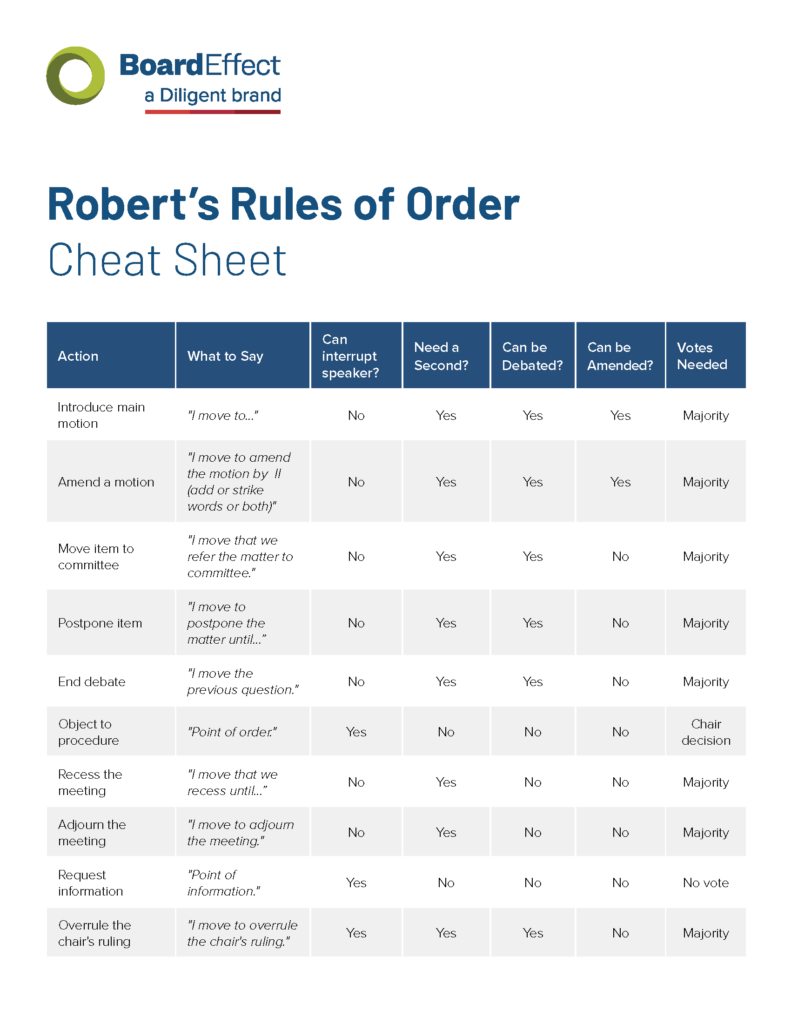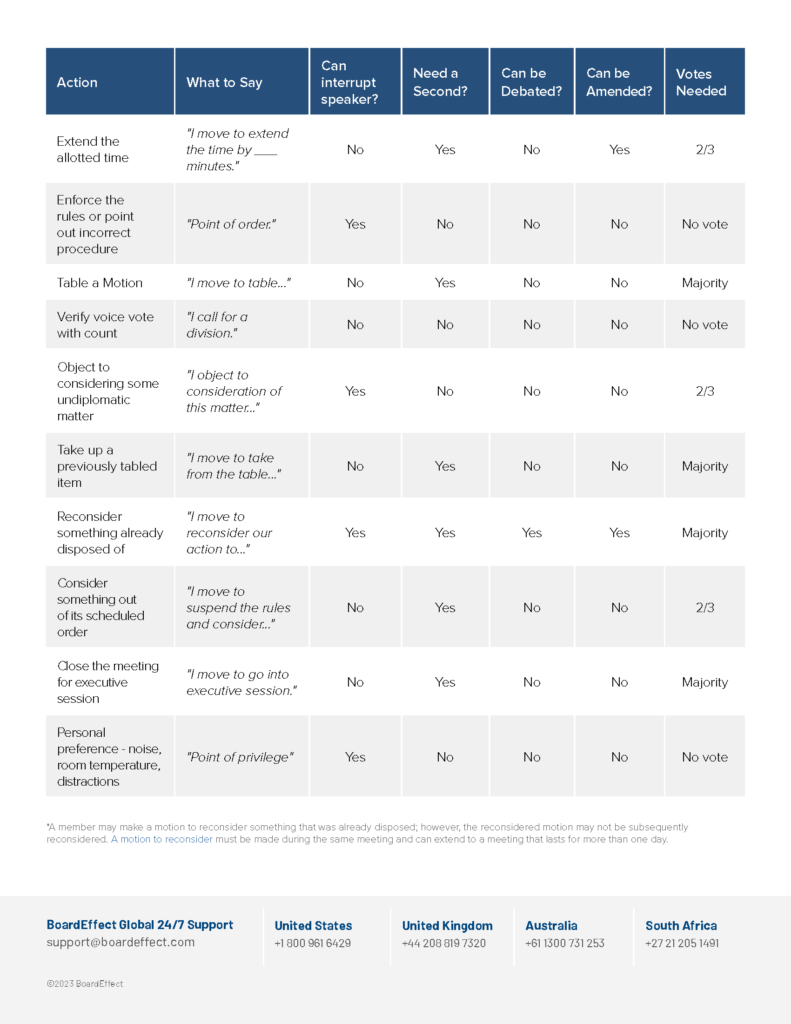

Robert’s Rules of Order is a lengthy manual of parliamentary procedure that governs most boards of directors, which was first created in 1876 by Henry Martyn Robert as an adaptation of the rules and practices of Congress. With the latest versions of the manual totaling around 700 pages, a Robert’s Rules of Order cheat sheet is useful for highlighting the most common processes used by today’s boards.
To help simplify Robert’s Rules of Order, we’ll provide an overview of the following topics:
Robert’s Rules is a framework that is comprised of a set of codes and rules of ethics that helps groups hold orderly meetings that allow the majority to rule while allowing minority voices to be heard.
There are four primary types of motions in Robert’s Rules of Order:
Robert’s Rules of Order for meetings is the general standard for how nonprofit boards, committees and other established groups govern discussions and decision-making. Most nonprofits and groups use Robert’s Rules because it ensures order and creates a ripe environment for productivity.
A parliamentary procedure can be any set of rules and guidelines a group formally establishes to govern themselves, with Robert’s Rules of Order being the most common type.
The goal of the parliamentary procedure is to set forth the order of discussions and ultimately get to a place where all group members can agree on what they want to accomplish or how to move forward. By using an established set of rules and guidelines, members of the group can reach a consensus in a respectful, collegial manner.
New board members should learn the basics of Robert’s Rules as soon as they join a board. Board members will use the basic rules for making decisions at most meetings.
Here is a general outline of the essential elements of Robert’s Rules:
If anything out of the ordinary comes up, board members can look up the rules during the meeting. When you store a copy of Robert’s Rules in your board management system, it is quickly and easily accessible if there is a question on proper meeting protocols.
We have updated the Robert’s Rules of Order Cheat Sheet, available in a downloadable format here. Print or download this to keep at your fingertips for running even more effective board meetings.


Board members must discuss one issue at a time to keep order in the boardroom. The board chair should only allow one person to speak at a time. Any member who wants to make a motion must request the floor —and be granted it — before speaking.
Robert’s Rules classifies motions into the below categories.
You can read more about these motions here.
You can read more about the motions and how to use them in this article, “Robert’s Rules of Order: Types of Motions”.
TIP! If the board is in obvious agreement, the chairperson may save time by stating, “If there is no objection, we will adopt the motion to…” Then wait for any objections. Then say, “Hearing no objections, (state the motion) is adopted.” And then state any instructions.
If a member objects, first ask for a debate, then vote, and then announce the vote.
Certain situations need attention during the meeting, but they don’t require a motion, second, debate, or voting. It’s permissible to state a point during a meeting where the chairperson needs to handle a situation right away. Board members can declare a Point of Order, Point of Information, Point of Inquiry, or Point of Personal Privilege.
*Note: A member may make a motion to reconsider something that was already disposed of; however, the reconsidered motion may not be subsequently reconsidered. A motion to reconsider must be made during the same meeting and can extend to a meeting that lasts for more than one day.
Robert’s Rules of Order was developed to ensure that meetings are fair, efficient, democratic and orderly. A skilled chairperson allows all members to voice their opinions in an orderly manner so that everyone in the meeting can hear and be heard. The following tips and reminders will help chairpersons run a successful and productive meeting without being run over or running over others.
All board members should be familiar with Robert’s Rules of Order, which they can find online and in bookstores, and this Robert’s Rules of Order cheat sheet for 2023 is a handy resource for your board and all new members.
Now that we’ve covered the basics, a deeper understanding of Robert’s Rules is essential. The next step is to learn how to handle abstentions for a more streamlined board procedure. In our article, the six reasons why nonprofit board members abstain, we discuss this topic in length.
Robert’s Rules of Order for meetings is an informative and fascinating topic. The more board members learn about how to use Robert’s Rules, the more effectively they will govern, and effective governance is the hallmark of a quality board.
Most Popular Posts
Comparing different board portal vendors to ultimately make a selection is serious business. After all,…

Anyone who has started a nonprofit organization from scratch knows that it’s not an easy…

Procedures are fundamental when it comes to nonprofit voting, and Robert’s Rules for voting abstentions…